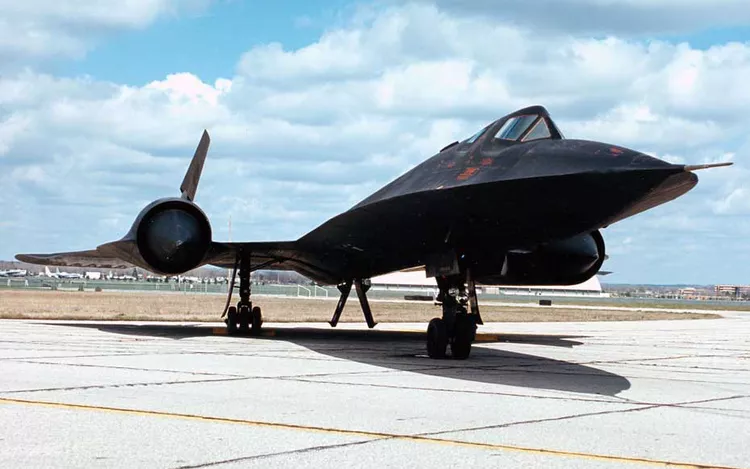Bond wishes he had a bird like this.
The SR-71 was a spy plane born to rule the skies and is one of the greatest feats of engineering ever to take off. The Blackbird is native to California, hatched at Lockheed Martin’s Skunk Works, which has a hard-earned reputation for making the impossible happen.
While Blackbirds now only grace museums in the U.S. and U.K., in over two decades of active duty they had two careers supporting espionage and science.
The Blackbird program was an enigma, an impossibility, and ultimately a controversy, but even in retirement these are still among the world’s sexiest jets.
:max_bytes(150000):strip_icc():format(webp)/sr71-blackbird-nose-SR710517-3727ef4a6ad846f9bcb3c05481129262.jpg)
Even if you think you know all of the Blackbird’s secrets, a good spy always holds something back. Here are some details which might surprise you:
Key Facts About the SR-71 Blackbird
- Blackbirds can fly at altitudes higher than 85,000 feet and at speeds exceeding three times the speed of sound (up to Mach 3.3). That’s more than 2,000 miles per hour.
- These jets were equipped with a variety of sensors suited to each intelligence run, including specialized framing cameras that captured detailed black and white images of objects as small as nine inches in diameter, along with a high-resolution radar imaging system operable day or night, regardless of weather conditions. A Blackbird could photograph 100,000 square miles in an hour.
- For the Blackbird, record speeds weren’t good enough. They needed stamina to sustain high speeds at altitude for hours. This requirement called for new materials that could withstand heat from friction, reaching temperatures as high as 1,000 degrees Fahrenheit, while flying in an environment of -60 degrees Fahrenheit.
- The Blackbird got its name due to its need to keep cool under pressure. Skunk Works applied black paint as it is an optimal temperature regulator, enhancing it with an element that made it virtually invisible to radar.
- Soviet radar advancements forced the Blackbird’s design to be optimized to prevent detection. Skunk Works redesigned surfaces and relocated the engines to a mid-wing position, effectively reducing the radar cross section of this 110-foot-long plane by 90 percent.
- Titanium alloy was the only metal suitable for the Blackbird’s frame, being strong yet relatively lightweight. However, Titanium posed challenges in production; Lockheed had to innovate new titanium tools and provide special training for machinists to adapt.
- Blackbirds were powered by Pratt & Whitney J58 axial turbojets, recognized as the world’s first adaptive engines capable of handling the rigorous demands of sustained flights above Mach 3.
- Each jet produced 32,500 lb of thrust, but surprisingly, less than 20 percent of the thrust required to reach Mach 3 came from the engines alone; the rest was generated by air passing through the engine inlet and the conical spike at the front of each engine’s nacelle.
- The J58 engines produced a blue-yellow-orange flame 50 feet long, characterized by a series of shock patterns, giving the appearance of the plane spitting fireballs.
- Pratt and Whitney originally developed the J58 engine in 1958.
- Although the Blackbird’s design dates back to the late 1950s, its existence remained classified until 1976.
- The JP-7 fuel used to power the Blackbirds was custom-developed by Shell Oil. Its low volatility allowed it to absorb significant heat during operation while the jets could hold up to 12,000 gallons of fuel.
- According to folklore, a match dropped into a bucket of JP-7 fuel was instantly extinguished, illustrating the high flashpoint of this unusual fuel, although this story is backed by scientific fact about how low-volatility fuel behaves.
- JP-7 ignited through a chemical reaction with Triethylborane (TEB), a substance that spontaneously combusts when exposed to air.
- The smaller A-12 variant was the Blackbird’s predecessor, taking its first flight in April 1962.
- The Cuban Missile Crisis significantly advanced the Blackbird program, especially after a U-2 reconnaissance mission was downed over Cuba in October 1962. By July 1963, the Blackbird proved its capabilities by flying Mach 3 at 78,000 feet, with its first flight occurring on Dec. 22, 1964.
- The high operational costs and the onset of the Cold War’s end led to the Air Force retiring the Blackbirds in 1990. Despite this, some Senate Select Committee on Intelligence members advocated for their continued use, resulting in Congress reviving three jets between 1995 and 1998.
- From 1990 to 1997, NASA utilized four SR-71 Blackbirds for aeronautical research.
- The Blackbird helped NASA with better sky observation. An upward-gazing ultraviolet video camera was employed to track celestial objects that Earth’s atmosphere blocked, rendering them invisible to ground-based astronomers.
- NASA also involved the Blackbird in efforts to preserve and restore the ozone layer.
- The NASA Blackbird program contributed to advancements in technology, notably influencing the development of Motorola’s IRIDIUM Satellite Communications program, assisting in testing ground-based transmitters and receivers.
- Likewise, the program led to improvements in commercial passenger aircraft, studying turbulence dynamics.
- The NASA SR-71 program might enhance a better supersonic passenger flying experience in the future by researching the thunderclaps produced when breaking the sound barrier. This knowledge aids the QueSST ‘heartbeat’ quiet supersonic plane project.
- Lastly, it comes as no surprise that the pilots who soared the Blackbird developed a profound love for it.
- However, pilots couldn’t fly these spy planes dressed in formal attire; instead, they wore specialized pressurized suits and astronaut-like helmets, with hoses supplying 100 percent oxygen to protect against decompression sickness at high altitudes.
:max_bytes(150000):strip_icc():format(webp)/sr71-blackbird-cockpit-SR710517-7de3328b429948aabfd9573a7722bf76.jpg)
:max_bytes(150000):strip_icc():format(webp)/sr71-blackbird-cockpit-detail-SR710517-0217e052ca464ac391e77c0f1be5ebfe.jpg)




